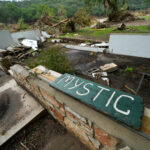The cleanup of history’s worst peacetime oil spill is generating thousands of tons of oil-soaked debris that is ending up in local landfills, some of which were already dealing with environmental concerns.
The soft, absorbent boom that has played the biggest role in containing the spill alone would measure more than twice the length of California’s coastline, or about 2,000 miles (3,200 kilometers). More than 50,000 tons of boom and oily debris have made their way to landfills or incinerators, federal officials told the Associated Press, representing about 7 percent of the daily volume going to nine area landfills.
A month after the oil stopped flowing into the Gulf, the emphasis has shifted toward cleanup and disposal of oily trash at government-approved landfills in coastal states.
Environmental Protection Agency officials say the sites meet federal regulations, are equipped to handle the influx of waste and are being monitored closely, although three sites have state environmental issues. State records show two are under investigation and one was cited in May for polluting nearby waters.
Some residents and experts question the wisdom of adding crude-covered refuse to dumps, since it could take years for potential problems to surface. They worry about the impact on groundwater if contaminants leach past liners enclosing the decaying garbage.
“Common sense would tell you you probably shouldn’t keep dumping there if there are already problems,” said Eric Schaeffer, a former head of the EPA’s enforcement office who now heads a Washington-based legal advocacy group. “EPA needs to be able to say why despite the violations and discharges these are safe.”
Weathered oil is less toxic than fresh oil, the EPA says, but can still contain some levels of benzene and other risky chemicals.
Both BP and the EPA are sampling the waste each week at the landfills, and the EPA and U.S. Coast Guard officials alike say so far it has not turned out to be hazardous. In some landfills, the spill waste is being mixed directly with regular household and industrial trash, which can contain chemicals, plastics and food.
It is too soon to tell if the potential hazards from the oily waste would be greater than any risks posed by what’s already in the landfills, experts say. That will depend on the volume of the Gulf trash, the mass of industrial chemicals already there and how all those agents interact over time, said Conrad Volz, who directs the University of Pittsburgh’s Department of Environmental and Occupational Health.
In the meantime, the alternative to using already troubled landfills is placing oily waste in other dumps without environmental issues – where oily waste’s potential impacts could be tracked separately, experts say.
“The oily waste may not be the most toxic thing in those landfills,” said Kurt Pennell, an environmental engineer at Tufts University who sits on a National Research Council committee studying groundwater problems near landfills and Superfund sites. “But obviously if … the landfill isn’t well controlled, that is problematic.”
EPA Assistant Administrator Mathy Stanislaus, who oversees the agency’s waste management plans, said the landfills can handle the oily waste properly.
“The landfills … have the system in place, the kind of liner, the kind of monitoring systems to manage this so that there are not environmental impacts,” Stanislaus said in an interview. “If there are any issues of concern, we will revisit.”
The Gulf trash’s trip to the landfill begins in oiled marshes and beaches where tar balls washed up regularly. Recently, near the mouth of the Mississippi, workers standing in small boats collected 16,000 feet (4,900 meters) of oily absorbent boom in one day alone from waters surrounding one oil-covered marsh.
The boom is wrung out and dried before being shipped to landfills or incinerators.
Concerns about pollution prompted Harrison County, Miss., supervisors to decide against accepting more oily waste in their coastal county, which is recovering from Hurricane Katrina in 2005.
Waste is being trucked to the Chastang Landfill 25 miles (40 kilometers) north of Mobile, Alabama, where state officials are investigating high levels of mercury and barium found in the dump’s groundwater monitoring wells.
Nearby residents said they were worried that more chemicals were coming to the facility.
“We already got enough problems here, and now they’re going to bring us the oil and everything that comes out of those Gulf beaches?” said Lawrence Andry, 70.
The landfill’s owner, Waste Management, believes the water contamination is the result of naturally occurring metals in the soil, not the dump, and is performing tests, said spokesman Ken Haldin.
Gulf waste also is taken to the county-run Magnolia Landfill about 60 miles (100 kilometers) south in Summerdale, Ala., which is being investigated for groundwater tainted with arsenic, acetone and other pollutants. State officials fined the dump $30,000 last month for failing to properly monitor methane flares used to burn off gas from the heap.
Ed Fox, who manages the facility, said people should not worry because the well water used to monitor pollution is tested twice a year.
The Colonial Landfill in Sorrento, La., which is receiving Gulf waste, was cited in May for exceeding its permitted spills into a stream feeding the Lake Pontchartrain basin 11 times last year. State officials said the dump fixed the problem last month, but got another state citation for failing to show inspectors log books and install proper barriers around its monitoring wells – problems the operator says were addressed. Louisiana environmental authorities said Friday they are still in violation.
When informed that three landfills had issues, Stanislaus said EPA officials had visited the facilities and knew of the deficiencies, but that didn’t disqualify them from accepting spill waste.
“We take these issues very seriously,” he said. “If we find any major violations at any landfill that would impact the health of communities, and the state doesn’t step in and act swiftly … the on-scene coordinator and EPA will step in and stop any waste shipment.”
BP’s three waste hauling contractors say they’re following strict procedures to ensure safe disposal, as do operators of the receiving dumps. Houston-based Waste Management Inc. has a contract to dispose of waste from Mississippi, Alabama and part of the Florida Panhandle. The rest of Florida is handled by Phoenix-based trash hauler Republic Services Inc., and Heritage Environmental Services has the BP contract for Louisiana.
Burke reported from Fresno, Calif.
Was this article valuable?
Here are more articles you may enjoy.

 ‘Door Knocker’ Roofers Were Everywhere. NC Farm Bureau Saw an Opportunity
‘Door Knocker’ Roofers Were Everywhere. NC Farm Bureau Saw an Opportunity  New York Times Reporter Sues Google, xAI, OpenAI Over Chatbot Training
New York Times Reporter Sues Google, xAI, OpenAI Over Chatbot Training  World’s Top 10 Extreme Weather Events in 2025
World’s Top 10 Extreme Weather Events in 2025  Jump Trading Faces $4 Billion Terraform Administrator Suit
Jump Trading Faces $4 Billion Terraform Administrator Suit 